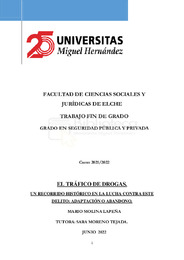Por favor, use este identificador para citar o enlazar este ítem:
https://hdl.handle.net/11000/28802Registro completo de metadatos
| Campo DC | Valor | Lengua/Idioma |
|---|---|---|
| dc.contributor.advisor | MORENO TEJADA, SARA | - |
| dc.contributor.author | Molina Lapeña, Mario | - |
| dc.contributor.other | Departamentos de la UMH::Ciencia Jurídica | es_ES |
| dc.date.accessioned | 2023-01-26T12:47:56Z | - |
| dc.date.available | 2023-01-26T12:47:56Z | - |
| dc.date.created | 2022-09-03 | - |
| dc.identifier.uri | https://hdl.handle.net/11000/28802 | - |
| dc.description.abstract | Este trabajo persigue llevar a cabo un análisis de la problemática policial con la que conviven día a día los policías que patrullan las barriadas con mayores índices delincuenciales, convertidas en auténticos guetos. En concreto, la investigación gira en torno al menudeo de drogas que se produce en todos los barrios marginales de las grandes ciudades, incentivado por la nula adaptación a las realidades delictivas de un modelo policial obsoleto que deriva en el abandono de estas zonas, consiguiendo crear auténticos guetos, lugares donde el delincuente se encuentra en su zona de confort y los policías sufren un coste elevado en sus actuaciones. El lector de este trabajo estará orientado por un estudio histórico y minucioso acerca de las drogas, su consumo, las unidades dedicadas a su persecución y las evolución legislativa a través de los años y comprobará con ejemplos de hechos ya ocurridos y totalmente objetivos el fundamento y valor de la puesta en marcha de ciertas teorías criminológicas, orientándolo en el conocimiento de la realidad policial actual y consiguiendo comprender las soluciones propuestas. Para cumplir este objetivo se ha utilizado bibliografía sobre autores de teorías criminológicas como Travis Hirschi o Ronald Akers con sus teorías del control social y del aprendizaje social respectivamente, los estudios y experimentos del sociólogo Philip Zimbardo con sus ventanas rotas y la teoría de la prevención del delito a través del diseño ambiental de los autores Ray Jefery y Oscar Newman, así como fuentes directas obtenidas del criminólogo Samuel Vázquez y el ex comisario de la Policía de la ciudad de Nueva York William J. Bratton. | es_ES |
| dc.description.abstract | This work is presented with the hope of offering a less extensive view of police problems, focused on the problems that the police officers who patrol the neighborhoods with the highest crime rates, converted into authentic ghettos. The professional experience of the author of this investigation as a member of the State Security Forces, together with the study of the most successful police model in the world, together with the review of the direct application of various criminological theories that, if they work, make possible the drafting of it. The work revolves around the drug retail that occurs in all the marginal neighborhoods of the big cities, caused by the lack of adaptation to the current criminal realities of an obsolete police model that leads to the abandonment of these areas, managing to create authentic ghettos, places where the offender is in his comfort zone and the police suffer a high cost in their actions. The reader of this work will be guided by a historical and detailed study about drugs, their consumpcion, the units dedicated to their persecution and the legislative evolution through the years and will verify with examples of events that have already occurred and totally objectively, the foundation and value of the implementation of certain criminological theories, guiding him in the knowledge of the current police reality and managing to understand the proposed solutions. To meet this objective, bibliography has been used on authors of criminological theories such as Travis Hirschi or Ronald Akers with their theories of social control and social learning, respectively, the studies and experiments of the sociologist Philip Zimbardo with his broken windows and the theory of crime prevention through environmental design by authors Ray Jefery and Oscar Newman, as well as direct sources obtained from criminologist Samuel Vazquez and former New York City Police Commissioner William J. Bratton. | es_ES |
| dc.format | application/pdf | es_ES |
| dc.format.extent | 34 | es_ES |
| dc.language.iso | spa | es_ES |
| dc.publisher | Universidad Miguel Hernández de Elche | es_ES |
| dc.rights | info:eu-repo/semantics/openAccess | es_ES |
| dc.rights | Attribution-NonCommercial-NoDerivatives 4.0 Internacional | * |
| dc.rights.uri | http://creativecommons.org/licenses/by-nc-nd/4.0/ | * |
| dc.subject | Policía | es_ES |
| dc.subject | Modelo policial | es_ES |
| dc.subject | Droga | es_ES |
| dc.subject | Menudeo | es_ES |
| dc.subject | Gueto | es_ES |
| dc.subject.other | CDU::3 - Ciencias sociales::34 - Derecho::343 - Derecho penal. Delitos | es_ES |
| dc.title | El tráfico de drogas. Un recorrido histórico en la lucha contra este delito: adaptación o abandono. | es_ES |
| dc.type | info:eu-repo/semantics/bachelorThesis | es_ES |

Ver/Abrir:
TFG-Molina Lapeña, Mario.pdf
980,87 kB
Adobe PDF
Compartir:
 La licencia se describe como: Atribución-NonComercial-NoDerivada 4.0 Internacional.
La licencia se describe como: Atribución-NonComercial-NoDerivada 4.0 Internacional.
.png)